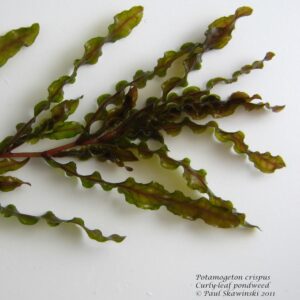Curly Leaf Pondweed
Aquatic plant management: curly leaf pondweed
What is curly leaf pondweed?
In the Great Lakes region, some people call pondweeds “lake cabbage” or fishing weeds.” Curly leaf pondweed (Potamogeton crispus) is a submerged pond weed with roots. Its coloration varies from olive-green to reddish-brown. Wavy, lasagna-like leaves grow about a half-inch wide and 2-3” long. Curly leaf pondweed leaves have a mid-vein, “toothed” or serrated edges, and blunt tips. The main stem can vary in color like white, green, brown, and red. It tends to branch multiple times near the top of the plant. The underwater plant may mat at the surface but does not have true floating leaves. It is often the first pondweed to come up in the spring. It can flower, fruit, and produce turions (turions are reproductive structures that persist in the sediment – they look like small pinecones). This happenes in June before dying back in mid-summer. Curly leaf pondweed looks similar to many native beneficial pondweeds found in lakes and rivers. It can be distinguished based on its serrated leaf edges.
 Can curly leaf pondweed be controlled?
Can curly leaf pondweed be controlled?
Several kinds of pond weed killer (aquatic herbicides like aquacide, diquat, and fluridone in particular), and water drawdown, have shown effects at long-term control of this water plant. Eradication is unlikely due to the presence of the turions in the sediment. Understanding its unique growth cycle is important for control as the submerged pond weeds have both a spring and an overwintering form. Treatments should done early in the spring when the fishing weeds are small to prevent turion production. Water temperature is also an important component of aquatic herbicide control strategies. Curly leaf pondweed grows earlier in the spring than other cabbage weeds in lakes. This allows for certain aquatic herbicide treatments early in spring to be selective for only curly leaf pondweeds, when other native underwater plants and pond weeds are still dormant. Given the non-target impacts of pond weed killer (see “Herbicide control” fact sheet for more information), any control effort of pond weeds using aquatic herbicides should be carefully considered. For example, if the aquatic plant patches do not hurt recreation, or are mixed with native aquatic plants and algae, treatment may not be worthwhile (in terms of both non-target impacts and cost). Water drawdown is effective if the exposed bottom layer of the lake is dried and sufficiently frozen to kill dormant turions. Bottom barriers have shown effectiveness at combating curly-leafed pondweed in small areas. Mechanical harvesting (i.e. lake weed cutting and pulling) of curly-leaf pondweed for short term relief can be effective if timed correctly. These physical and mechanical lake management methods also have non-target impacts and should be carefully considered (see “Mechanical and physical control methods” fact sheet).
Where do I find out more?
Curly leaf pondweed is relatively common in lakes. If your lake has nuisance levels of this pond weed, you should contact a lake management service to help decide how to proceed if lake weed control is needed. (see the “Management Plan” fact sheet for information on finding a lake management service provider). The state’s natural resource agency is also a good resource for technical advice on the management of nuisance and invasive aquatic plants. Factors that may decide how aquatic weed control is attempted include: how much of the lake is populated by curly leaf pondweeds? Do the curly leaf pondweed patches also have native aquatic plants? Has the amount of curly leaf pondweed been staying about the same or increasing? For those lakes without this pond weed, early detection allows a small chance for eradication. At the least, early detection will make subsequent lake weed control efforts less costly and labor-intensive.